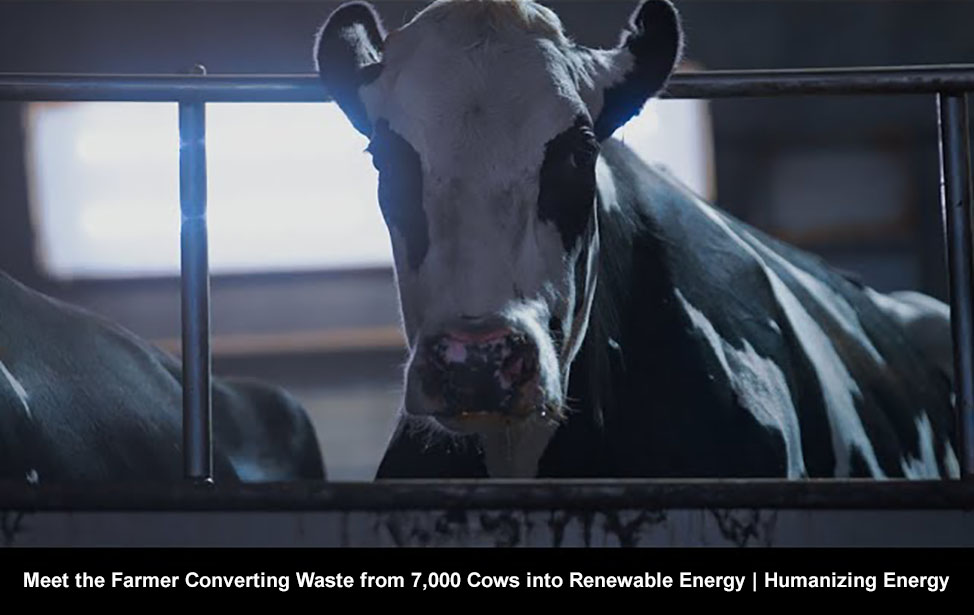Biogas Energy
Our fuel cells turn potent greenhouse gas into clean energy. Learn how biogas energy generation can harness the power of waste.
Bar20 Dairy
Kerman, CA
Waste to Electricity
Highest Efficiency, Lowest Carbon Intensity
Minimal Upgrading of Biogas
No
Combustion
Proven
Platform
100% Methane Destruction
Bloom Energy’s solid oxide fuel cells (SOFCs) provide an electrochemical pathway to converting biogas to electricity without combustion, producing carbon-negative electricity with near zero air pollution and water usage.
Our biogas energy technology exhibits the highest electrical efficiency among commercially available technologies and produces the maximum amount of electricity from a fixed volume of biogas. This is accomplished while destroying methane and avoiding the increased GHG contributions the methane would otherwise create.
What is Biogas?
Biogas is a valuable byproduct of decomposing organic waste, typically generated from agricultural, municipal, and industrial sources. When organic matter decomposes anaerobically (without oxygen), it produces a mixture of gases, primarily methane (CH4) and carbon dioxide (CO2), along with small amounts of other gases. If left untreated, biogas acts as a dangerous pollutant, with methane causing the most concern due to its high global warming potential. Harnessing biogas for energy can significantly reduce methane emissions on farms and other waste-producing facilities, turning a potent greenhouse gas into a renewable energy source.
What is Methane?
Methane is a powerful greenhouse gas generated from the anaerobic decomposition of organic waste. It traps heat in the atmosphere much more efficiently than carbon dioxide, with a Global Warming Potential (GWP) over 25 times greater. This makes methane a key contributor to global emissions and climate change. In agricultural settings, reducing methane on farms is crucial for mitigating environmental impact and improving air quality.
How is Methane from Waste Addressed?
Addressing methane emissions from waste involves several traditional methods:
- Venting: Releasing methane directly into the atmosphere, which exacerbates greenhouse gas effects.
- Flaring: Burning methane to convert it into less harmful carbon dioxide, although this still contributes to CO2 emissions.
- Combustion through an Engine: Utilizing methane as a fuel for engines to generate electricity or heat, reducing methane emissions.
- Pipeline Injection: Treating and purifying biogas to meet pipeline quality standards for injection into natural gas pipelines, a capital-intensive but effective method.
By implementing these methods, especially in agricultural settings, significant strides can be made in reducing methane emissions from farms. This not only helps in managing waste more sustainably but also in mitigating the impacts of climate change.
Why Energy Efficiency Matters
Harnessing the power of waste to generate useful energy is an important tool towards achieving a net zero future. A biogas generator that can convert this waste to electricity at the highest efficiency possible ensures that we’re making the greatest contribution towards decarbonization. The Bloom Energy Server converts waste to electricity 40% more efficiently than combustion-based alternatives.
70,000,000
Tons of Organic Waste
The United States produces more than 70 million tons of organic waste each year.

How a Biogas Fuel Cell Works to Generate Renewable Electricity
1. Collect & Digest
Organic waste and its byproducts contain an enormous amount of untapped energy potential. The most common form of recovery is through anaerobic digestion. Digesters break down bio waste to create biogas primarily consisting of methane.
2. Clean & Convert
Specialized gas conditioning equipment processes the raw biogas into a suitable feed for use within the fuel cells of Bloom Energy Servers, which then converts it into electricity via a non-combustion electrochemical reaction, virtually eliminating NOx, SOx, and other harmful criteria pollutants from the environment.
3. Plug In & Power
Once treated within the system, the biogas can be fed as fuel to Bloom Energy’s Servers, which will generate clean electricity via an electrochemical reaction. Together, these technologies function as biogas energy generators and create an end-to-end solution for the capture, clean-up, and generation of renewable electricity from waste.

Attractive Economics for all Segments of Biogas
Charts are illustrative. Actual numbers will vary by project. RFS Value assumes biogas to electricity becomes an eligible pathway via eRINs
Waste to
Renewable Fuel
Bloom can provide the power and heat needs for a RNG or similar renewable fuels facility onsite – resulting in greater reliability, cost predictability and lower carbon intensity for facilities with Renewable Identification Numbers (RINs), which are being used to track the production, trading and use of renewable fuels in the U.S.
Illustrative Value Streams

Biogas Treatment Highlights
Bloom Energy Servers can utilize proven, off-the-shelf gas conditioning equipment to process raw biogas into a suitable fuel for power generation.
![]() O2 removal not required
O2 removal not required
![]() N2 removal not required
N2 removal not required
![]() Lower pressure requirement than pipeline injection
Lower pressure requirement than pipeline injection
The Bloom Energy Experience: Biogas and Renewable Energy at Scale
Bloom Energy has been at the forefront of the energy transition since its inception, working to offer better alternatives to energy generation and delivery for nearly two decades. The versatility of our core solid oxide platform creates distinct advantages that enable applications across the entire energy value chain.
In operating our global fleet, Bloom has developed significant technical insights generating over 800 billion cell hours in the field. Our costs to manufacture have decreased dramatically, allowing a significant expansion of technological capabilities, increasing stack lifetimes and improving system efficiencies.
Our experience as a developer of fuel cell projects, in addition to our role as an OEM, provides us with the skill sets required to engage customers with turnkey solutions, develop model and finance portfolios, deliver competitive projects and consistently target mutually profitable opportunities for ourselves and our customers.
As we continue to innovate, we are deeply confident in our ability to leverage our scale, experience, continued cost improvements and core efficiency advantages to deliver the greatest value and provide the solutions needed to propel our customers towards a better energy future.
$1.3 B
2023 revenue
22B kWh
Produced without combustion
> 1.2 GW
Deployed
~1200 installations
> 170 Microgrids







